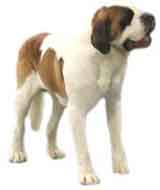Big DogsInformation About The Saint Bernard Dog Breed |
|
|
History and origin : The Saint Bernard is a descendant of the Roman Molossian dogs and is named after the St. Bernard Hospice in the Swiss Alps. He was introduced between 1660 and 1670, where he became famous for rescuing climbers in the Alps. Before his job as a rescue dog in the Alps, the Saint Bernard was used by the Romans and was probably first brought to Switzerland by them. Description : The Saint Bernard stands 25 to 30 inches at the shoulder and weighs upwards of 180 pounds. He is an enormous, powerful, and big-boned breed. There are two versions, the long-haired and the short-haired. There are no discernible behavioral differences between the two, the long-haired coat requiring only slightly more grooming. Both shed. The color may be red-and-white, brown-and-white, or brindle-and-white. About the breed : The Saint Bernard is a powerful but gentle breed. He is friendly, loyal, and affectionate with his owners. His good nose along with his tendency to be a bit stubborn are the major obstacles to training. A firm yet patient training technique is required. Remember that giant breeds mature slowly; a six-month-old Saint Bernard may weigh 100 pounds, but he will have a puppy mind-set, so go slow. Do not underestimate this dog's size and strength. A well-bred Saint Bernard is a mellow, affectionate, lazy dog who will protect your home, but not with the same ferocity as a Rottweiler. A fairly quiet breed, he normally gets along well with other people and dogs. Of the giant breeds, the Saint Bernard and the Newfoundland are possibly the friendliest and best with children. The Saint Bernard can make a good family dog, but he must be obedience-trained early because of his tremendous size. Like any giant dog, he can hurt a child without meaning to. In addition, similar to other giant breeds, the Saint does not live long. He has a life span of about 10 years. He is also prone to heart problems, bloat, and, because of his size, hip and shoulder problems. Do not let him get fat, and do not run with him. Hip surgery on this breed is very expensive. He also snores and drools, the males more than the females. Feeding : Recommended feeding for this breed is up to 4 cans (13.3oz) of a high-quality meaty product with biscuit added in equal amount or 5 cupfuls of a complete, dry dog food. This breed can eat 8-12 cups of food a day. Ideal home : He needs a house with a fenced yard. The owner of a Saint Bernard should be a firm, patient, confident leader who prefers a lazy, friendly pet. A weak or nervous owner may create a pushy dog that lacks confidence. Overbearing people could create a worried pet capable of fear-based aggression.Back to the Big Dog Breed article page
| |
|
Related News About Dogs ' ); // get rid of newsfeed display by carp CarpConf('poweredby',''); CarpCacheShow('http://classifieds.agriscape.com/syndicate/dogs.rss'); ?>
|
|
|
|
|
|
Copyright © 2006-2007 dogguidance.com |


